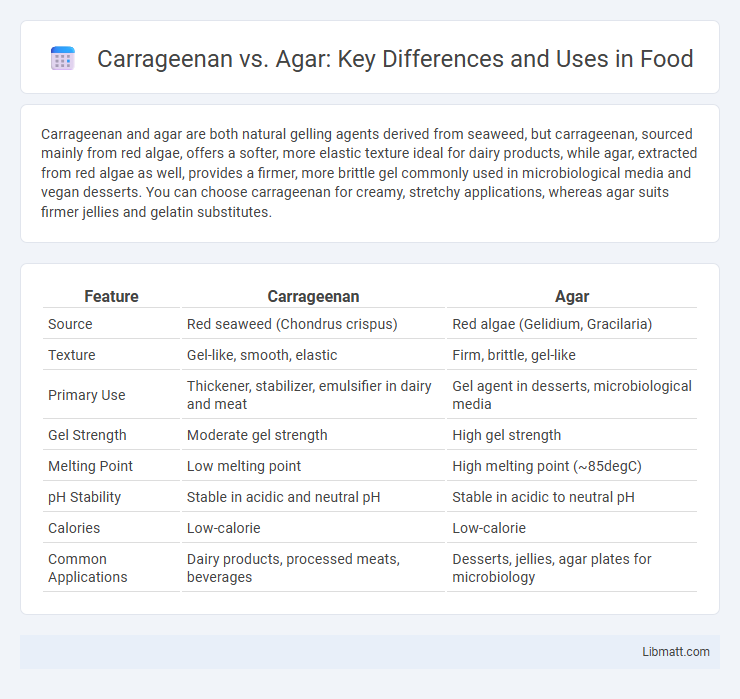Carrageenan and agar are both natural gelling agents derived from seaweed, but carrageenan, sourced mainly from red algae, offers a softer, more elastic texture ideal for dairy products, while agar, extracted from red algae as well, provides a firmer, more brittle gel commonly used in microbiological media and vegan desserts. You can choose carrageenan for creamy, stretchy applications, whereas agar suits firmer jellies and gelatin substitutes.
Table of Comparison
| Feature | Carrageenan | Agar |
|---|---|---|
| Source | Red seaweed (Chondrus crispus) | Red algae (Gelidium, Gracilaria) |
| Texture | Gel-like, smooth, elastic | Firm, brittle, gel-like |
| Primary Use | Thickener, stabilizer, emulsifier in dairy and meat | Gel agent in desserts, microbiological media |
| Gel Strength | Moderate gel strength | High gel strength |
| Melting Point | Low melting point | High melting point (~85degC) |
| pH Stability | Stable in acidic and neutral pH | Stable in acidic to neutral pH |
| Calories | Low-calorie | Low-calorie |
| Common Applications | Dairy products, processed meats, beverages | Desserts, jellies, agar plates for microbiology |
Introduction to Carrageenan and Agar
Carrageenan is a natural polysaccharide extracted from red seaweed, widely used as a gelling, thickening, and stabilizing agent in the food industry. Agar, derived from the cell walls of red algae, serves as a vegetarian gelatin substitute known for its strong gelling properties and rapid setting at room temperature. Both carrageenan and agar are valued for their unique molecular structures that enable texture modification in dairy products, desserts, and microbiological media.
Origin and Extraction Processes
Carrageenan is derived from red seaweed species such as Chondrus crispus and is typically extracted through hot water or alkaline processing to isolate its sulfated polysaccharides. Agar, primarily sourced from Gelidium and Gracilaria seaweed, undergoes boiling and cooling cycles to extract its gel-forming polysaccharides, mainly agarose and agaropectin. Understanding these distinct origins and extraction methods helps you choose the right hydrocolloid for food, pharmaceutical, or cosmetic applications.
Chemical Composition and Structure
Carrageenan is a sulfated polysaccharide derived from red seaweed, primarily composed of repeating galactose units with varying degrees of sulfation, which contribute to its gel-forming properties. Agar consists mainly of agarose and agaropectin, with agarose being a linear polymer of alternating D-galactose and 3,6-anhydro-L-galactopyranose units, providing a rigid gel network. The sulfation in carrageenan differs from agar's neutral agarose backbone, resulting in distinct gelling mechanisms and textures.
Gelling and Thickening Properties
Carrageenan and agar both serve as powerful gelling and thickening agents derived from seaweed but differ in their textural properties and melting points. Carrageenan forms a flexible, elastic gel ideal for dairy and meat products, with a melting point around 40degC, which allows it to remain stable at higher temperatures. Agar yields a firm, brittle gel that sets quickly at room temperature and melts above 85degC, making it suitable for applications requiring heat stability and clear gel formation.
Applications in Food Industry
Carrageenan, derived from red seaweed, is widely used in dairy products, processed meats, and beverages for its gelling, thickening, and stabilizing properties. Agar, extracted from red algae, is popular in desserts, confectioneries, and microbiological culture media due to its strong gel formation and clear, firm texture. Both hydrocolloids serve essential roles in enhancing texture and shelf life, with carrageenan favored in creamy and liquid foods, while agar excels in solid gel applications.
Health and Safety Considerations
Carrageenan and agar have distinct health and safety profiles, with carrageenan sometimes linked to gastrointestinal inflammation and potential immune reactions, especially in its degraded form, while agar is generally recognized as safe with minimal adverse effects. Research indicates that refined carrageenan used in food products is typically safe, though individuals with sensitivities should exercise caution. Agar's natural origin and fiber content contribute to its safety and beneficial digestive properties, making it a preferred choice for those concerned about inflammatory responses.
Vegan and Allergen Friendliness
Carrageenan and agar are both popular vegan-friendly gelling agents derived from seaweed, making them suitable for plant-based diets. Agar is generally hypoallergenic, posing minimal risk to those with food sensitivities, while carrageenan may cause digestive issues or allergic reactions in some individuals. Your choice between these two should consider allergen tolerance, especially if you have sensitive digestive health or specific allergen concerns.
Culinary Uses and Recipes
Carrageenan and agar serve distinct roles in culinary applications, with carrageenan commonly used as a thickener and stabilizer in dairy products like ice cream and yogurt, enhancing texture and preventing separation. Agar, derived from red algae, is popular in vegan and vegetarian recipes for its gelling properties, often used to create firm jellies, panna cotta, and aspics without refrigeration. Your choice between these hydrocolloids depends on the desired consistency and dietary requirements, as carrageenan offers smoother textures while agar provides firm, brittle gels.
Environmental Impact and Sustainability
Carrageenan, derived from red seaweed, often involves intensive harvesting practices that can disrupt marine ecosystems and reduce biodiversity, whereas agar is typically produced from Gelidium or Gracilaria species with more sustainable cultivation methods. The carbon footprint of agar production is generally lower due to less energy-intensive processing compared to carrageenan extraction, making agar a greener alternative in food and pharmaceutical applications. Both polysaccharides are biodegradable, but agar's stable supply chain and renewable resource base contribute to its superior environmental sustainability profile.
Comparative Summary: Which to Choose?
Carrageenan and agar are both natural hydrocolloids derived from red seaweed, widely used as gelling agents in food and pharmaceutical products. Carrageenan offers a smooth, elastic gel ideal for dairy applications and beverages, while agar provides a firmer, brittle gel suited for vegan-friendly desserts and microbiological media. Your choice depends on the desired texture, dietary requirements, and specific application needs, with agar favored for firmness and carrageenan for creamier consistency.
Carrageenan vs Agar Infographic

 libmatt.com
libmatt.com